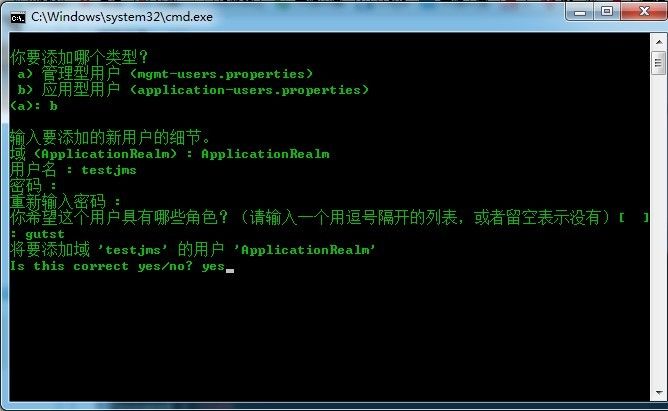JBOSS7.1下开发JMS(HoernetQ)的示例DEMO.
1.首先是要add-user.bat,添加用户,在jboss的bin目录下运行add-user.bat
照样添加就可以了.之后就是一路yes敲下去.
2.替换XML文件,CMD命令我用的不熟,折腾半天也没运行起JBOSS,伤心之余就跑去更换JBOSS的启动使用的XML文件了.D:\software\jboss-as-7.1.3.Final\standalone\configuration文件夹下,默认使用standalone.xml,你把他备份好,然后把standalone-full.xml的名字改为standalone.xml.因为那个啥,JBOSS7默认是没带JMS的.
3.修改Jboss配置文件standalone-full.xml(也就是现在的standalone.xml),找到hornetq-server节点,在该节点下的jms-destinations确定含有以下配置.
<jms-destinations>
<jms-queue name="testQueue">
<entry name="queue/test"/>
<entry name="java:jboss/exported/jms/queue/test"/>
</jms-queue>
<jms-topic name="ServerNotificationTopic">
<entry name="topic/ServerNotification"/>
<entry name="java:jboss/exported/jms/topic/ServerNotification"/>
</jms-topic>
</jms-destinations> 没就加上.
4.进入JBOSS控制台,看到JMS就是正确的了.擦,我的standalone.bat无法运行..才发现.不过Eclipse运行貌似一点问题没,JBOSS TOLL插件我全装了,汗.如图:
5.开始写代码,我都是写的main方法.注意把D:\software\jboss-as-7.1.3.Final\bin\client下的jar包弄上.
第一个是客户端的消息生产者:
package org.credo.jms;
import java.util.concurrent.CountDownLatch;
import java.util.concurrent.TimeUnit;
import java.util.logging.Logger;
import java.util.Properties;
import javax.jms.Connection;
import javax.jms.ConnectionFactory;
import javax.jms.Destination;
import javax.jms.MessageProducer;
import javax.jms.Session;
import javax.jms.TextMessage;
import javax.naming.Context;
import javax.naming.InitialContext;
/**
* <p>Description:JMS客户端消息生产者 </p>
*/
public class JMSProducer {
private static final Logger log = Logger.getLogger(JMSProducer.class.getName());
private static final String DEFAULT_MESSAGE = "the 4 message!";
// xml文件272行
private static final String DEFAULT_CONNECTION_FACTORY = "jms/RemoteConnectionFactory";
// xml文件293行,初次找JBOSS的JNDI太不容易了
private static final String DEFAULT_DESTINATION = "jms/queue/test";
private static final String DEFAULT_MESSAGE_COUNT = "1";
private static final String DEFAULT_USERNAME = "lion";
private static final String DEFAULT_PASSWORD = "123456";
private static final String INITIAL_CONTEXT_FACTORY = "org.jboss.naming.remote.client.InitialContextFactory";
private static final String PROVIDER_URL = "remote://localhost:4447";
public static void main(String[] args) throws Exception {
Context context=null;
Connection connection=null;
try {
// 设置上下文的JNDI查找
log.info("设置JNDI访问环境信息也就是设置应用服务器的上下文信息!");
final Properties env = new Properties();
env.put(Context.INITIAL_CONTEXT_FACTORY, INITIAL_CONTEXT_FACTORY);// 该KEY的值为初始化Context的工厂类,JNDI驱动的类名
env.put(Context.PROVIDER_URL, PROVIDER_URL);// 该KEY的值为Context服务提供者的URL.命名服务提供者的URL
env.put(Context.SECURITY_PRINCIPAL, DEFAULT_USERNAME);
env.put(Context.SECURITY_CREDENTIALS, DEFAULT_PASSWORD);//应用用户的登录名,密码.
// 获取到InitialContext对象.
context = new InitialContext(env);
log.info("初始化上下文,'JNDI驱动类名','服务提供者URL','应用用户的账户','密码'完毕.");
log.info("获取连接工厂!");
ConnectionFactory connectionFactory = (ConnectionFactory) context.lookup(DEFAULT_CONNECTION_FACTORY);
log.info("获取目的地!");
Destination destination = (Destination) context.lookup(DEFAULT_DESTINATION);
// 创建JMS连接、会话、生产者和消费者
connection = connectionFactory.createConnection(DEFAULT_USERNAME, DEFAULT_PASSWORD);
Session session = connection.createSession(false, Session.AUTO_ACKNOWLEDGE);
MessageProducer producer = session.createProducer(destination);
connection.start();
int count = Integer.parseInt(DEFAULT_MESSAGE_COUNT);
// 发送特定数目的消息
TextMessage message = null;
for (int i = 0; i < count; i++) {
message = session.createTextMessage(DEFAULT_MESSAGE);
producer.send(message);
log.info("message:"+message);
log.info("message:"+DEFAULT_MESSAGE);
}
// 等待30秒退出
CountDownLatch latch = new CountDownLatch(1);
latch.await(30, TimeUnit.SECONDS);
} catch (Exception e) {
log.severe(e.getMessage());
throw e;
} finally {
if (context != null) {
context.close();
}
// 关闭连接负责会话,生产商和消费者
if (connection != null) {
connection.close();
}
}
}
} 每次运行后如图:
JBOSS端如图所示:
每次向JBOSS的Queue发送消息成功的话,上面红圈的数字都会+1.
如果电脑重启,JBOSS重启,消息仍然是存在的.如果被接收了的话,消息就是消失.
2.客户端消费者代码:
package org.credo.jms;
import java.util.Properties;
import java.util.concurrent.CountDownLatch;
import java.util.concurrent.TimeUnit;
import java.util.logging.Logger;
import javax.jms.Connection;
import javax.jms.ConnectionFactory;
import javax.jms.Destination;
import javax.jms.MessageConsumer;
import javax.jms.Session;
import javax.jms.TextMessage;
import javax.naming.Context;
import javax.naming.InitialContext;
public class JMSConsumer {
private static final Logger log = Logger.getLogger(JMSConsumer.class.getName());
private static final String DEFAULT_CONNECTION_FACTORY = "jms/RemoteConnectionFactory";
private static final String DEFAULT_DESTINATION = "jms/queue/test";
private static final String DEFAULT_USERNAME = "lion";
private static final String DEFAULT_PASSWORD = "123456";
private static final String INITIAL_CONTEXT_FACTORY = "org.jboss.naming.remote.client.InitialContextFactory";
private static final String PROVIDER_URL = "remote://localhost:4447";
public static void main(String[] args) throws Exception {
ConnectionFactory connectionFactory = null;
Connection connection = null;
Session session = null;
MessageConsumer consumer = null;
Destination destination = null;
TextMessage message = null;
Context context = null;
try {
final Properties env = new Properties();
env.put(Context.INITIAL_CONTEXT_FACTORY, INITIAL_CONTEXT_FACTORY);
env.put(Context.PROVIDER_URL, PROVIDER_URL);
env.put(Context.SECURITY_PRINCIPAL, DEFAULT_USERNAME);
env.put(Context.SECURITY_CREDENTIALS, DEFAULT_PASSWORD);
context = new InitialContext(env);
connectionFactory = (ConnectionFactory) context.lookup(DEFAULT_CONNECTION_FACTORY);
destination = (Destination) context.lookup(DEFAULT_DESTINATION);
connection = connectionFactory.createConnection(DEFAULT_USERNAME, DEFAULT_PASSWORD);
session = connection.createSession(false, Session.AUTO_ACKNOWLEDGE);
consumer = session.createConsumer(destination);
connection.start();
// 等待30秒退出
CountDownLatch latch = new CountDownLatch(1);
while (message == null) {
log.info("开始从JBOSS端接收信息-----");
message = (TextMessage) consumer.receive(5000);
latch.await(1, TimeUnit.SECONDS);
}
log.info("接收到的消息的内容:" + message.getText());
} catch (Exception e) {
log.severe(e.getMessage());
throw e;
} finally {
if (context != null) {
context.close();
}
if (connection != null) {
connection.close();
}
}
}
}

然后继续看JBOSS的控制台,可以发现消息减少了一条.
参考自:http://lym6520.iteye.com/blog/1600630



